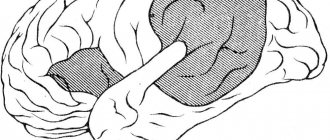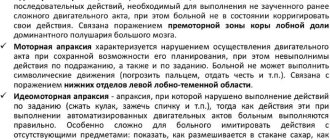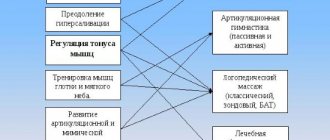If the left hemisphere of the brain is damaged, a person may develop a systemic disorder of speech function. It is called semantic aphasia.
This pathology is characterized by a violation of the understanding of complex grammatical structures, emerging elements of apraxia. Often a person loses orientation in space. The diseases are rare, but cause great inconvenience for the patient.
Clinical picture
Aphasia semantic aphasia refers to a disorder of the nervous system that is localized in the cerebral cortex. The disease manifests itself in disturbances in speech perception and reproduction.
Semantic aphasia occurs due to damage to three areas of the cerebral cortex. This includes:
- temporal,
- parietal,
- occipital
Pathology manifests itself in the problem of composing a simple text, comparing objects that are close and distant in meaning. During a conversation, a person’s semantic structure disintegrates. His speech becomes meaningless.
In addition to speech impairment, motor deviations may also be observed. For example, a person may become lost in space. The patient has problems with finger movement and lacks purposeful movements.
Sources
- Chomskaya E. D. Neuropsychology: 4th edition. - St. Petersburg: Peter, 2005 (Series “Classical University Textbook”).
- Luria A.R. Fundamentals of Neuropsychology: textbook. aid for students higher educational institutions / A. R. Luria. — 4th ed., erased. - M.: Publishing House, 2006.
- Luria A. R. Higher human cortical functions and their disturbances in local brain lesions. - 3rd ed. - M.: Academic Project, 2000.
- Balashova E. Yu., Kovyazina M. S. Neuropsychological diagnostics in questions and answers. - 3rd ed. - M.: Genesis, 2020.
Causes of pathology
Semantic aphasia occurs due to damage to the cerebral cortex. Most often this is associated with cerebrovascular accident and ischemic stroke. But internal problems do not always become the cause of the development of pathology. The disease can be triggered by the following factors:
- Postponed surgeries.
- Traumatic brain injuries.
- Tumor processes that occur in the brain.
- Inflammatory processes such as meningitis, encephalitis.
- The development of Pick's disease or Alzheimer's disease.
Depending on the dysfunction, there are several types of aphasia:
- Verbal aphasia, it manifests itself in the inability to form words.
- Semantic aphasia, characterized by an inability to understand words.
- Nominal form, a person cannot name familiar objects.
- Syntactic form, the patient is not able to correctly construct a sentence.
There are certain categories of citizens who belong to risk groups for the disease:
- suffering from hypertension,
- suffered traumatic brain injuries,
- suffering from cardiovascular diseases,
- in the presence of a disease of the central nervous system,
- elderly people over 50 years of age.
Cerebral atherosclerosis can also be the cause of aphasia.
Symptoms
A diagnosis such as semantic aphasia manifests itself not only as a speech disorder. The patient may have a problem not only with oral, but also with written speech. He simplifies speech structures, uses common phrases, but his hearing does not suffer at all.
The main types of symptoms include:
- Problem with the logical construction of thoughts.
- Use in a large number of service parts of speech when speaking.
- A person loses orientation in space.
- The patient cannot perform mathematical exercises.
- The ability to understand the indirect meaning of a word is lost. All phrases are perceived only in the literal sense.
- The patient cannot fulfill complex requests, for example, if there are two different tables in front of him, blue and red, and he is asked to put a red cup on the blue table, he will not be able to do this.
- Often, when naming an object, the patient uses descriptive constructions.
- A person does not understand the meaning between words and the construction of a sentence. But at the same time, the patient does not experience a change in his speech style.
The main symptoms of a semantic disorder are associated with the inability to understand the logic of sentence construction , as well as the use of the right words at a certain moment.
Story
Semantic-Pragmatic Disorder (SPD) was described by Rapin and Allen in 1983, although at that time it was described as a syndrome. They named a group of children who had mild autistic symptoms and semantic and pragmatic language difficulties.
Parents described their behavior in early childhood as exemplary, or, conversely, said that their children cried too much. Baby talk appeared very late or only slightly, and they continued to use “baby talk” for much longer than their peers. The first words appeared late, and in general learning the language was difficult. Some had other speech disorders. Parents usually began to worry when the child was between 18 months and 2 years old, due to the fact that he spoke only a few real words.
Some parents initially suspected deafness because the child did not respond to speech. The test generally found that most children had good hearing, although some were found to have otitis media and had tubes inserted to improve their hearing.
The reason here is rather that these children do not listen well and do not understand speech. Some children did not respond to their name, but responded to a doorbell, a telephone ringing, or even the rustling of wrapping paper. From an early age, children with SPD demonstrated difficulties with comprehension, such as being unable to follow directions outside of routine routines. Problems with understanding were usually overcome on their own or with the help of language therapy, and by the age of four the child seemed quite normal.
By the time the child entered school, both child care workers and parents noticed a difference between him and ordinary children, although they found it difficult to describe this difference. Sometimes these children said very little, and sometimes they could describe the situation in great detail. They were good at mathematics and other sciences, working with a computer, but it was much more difficult for them to form a coherent sentence or play with other children. They also could not share and give in return. They seemed aggressive, selfish, arrogant or too trusting, shy, unsociable. Many were isolated and punished for bad behavior, which, however, did not always produce results, but caused the child embarrassment and wonder what he did wrong. As one 6-year-old with SPD told his mother, “I don’t want to be rude.”
Classification of pathology
Many experts do not divide diseases into classifications. But there are doctors who classify aphasia into mild, severe and moderate:
- Easy , this is the phase in which the determination of cause-and-effect relationships is disrupted. A person cannot find synonyms, he has difficulties interpreting complex speech patterns. In addition, he cannot solve logical problems.
- Moderate degree is a pathology in which a person’s understanding of the logic of grammatical structures is impaired. The patient cannot solve mathematical problems and perform counting operations.
- In severe cases, visual impairment occurs. The patient also has problems with the perception of space.
Its effectiveness will depend on the stage at which treatment is started.
Treatment of the disease
Modern medicine uses several methods of therapy and prevention for the treatment of semantic aphasia. These methods include:
- The speech therapy method is the basis of therapy, which consists of restoring oral speech, as well as writing and reading. The patient is regularly prescribed individual sessions with a speech therapist, which are based on the traditional approach of consolidating linguistic skills in the patient’s speech. This method gives good results if, simultaneously with speech therapy treatment, a technique for restoring the functioning of the affected area of the brain is used.
- Surgical intervention may be prescribed to restore the functioning of speech zones. Its goal is to improve blood flow to the affected area of the brain. This is recognized to improve the functioning of nerve tissues.
- Physiotherapeutic procedures are used in combination with traditional treatment.
For treatment to be effective, the following conditions must be met:
- Regular blood supply to affected areas of the brain.
- Sufficient supply of oxygen to the brain.
- Daily activities that will affect areas of the brain located in the dead zone.
- It is important that during the treatment process the person experiences stressful situations to a minimum.
Treatment methods should be started as early as possible, when the first symptoms appear. Treatment should be carried out daily and be aimed at correcting not only oral, but also written speech.
In some cases, aphasia that occurs after a stroke can resolve on its own. But this happens extremely rarely, so when the first symptoms appear, you should consult a doctor.
Drug treatment is prescribed only by a neurologist in the hospital department. It involves taking medications that improve the supply of oxygen and nutrients to the brain. In the first three weeks they are prescribed in the form of injections, then they switch to taking tablets.
Acoustic-mnestic aphasia
This form of aphasia occurs with damage to the middle temporal gyrus of the 21st and 37th fields, i.e., the cortex of the second temporal gyrus of the left hemisphere.
It was first isolated and described by A. R. Luria. Previously, it was either mixed with sensory aphasia, considering this form of aphasia to be a stage in the development of the latter, or was called either conduction or transcortical motor aphasia. However, the clinic of aphasia and experimental data made it possible for A. R. Luria, and then his students (Tsvetkova,
1972a, 1974, 1975, etc.) to isolate the mechanism of this form of aphasia, describe the syndrome and compare it with sensory, identifying it as an independent form of aphasia.
Speech disorders resulting from damage to this area have been interpreted differently by different researchers. The clinical and psychological picture of speech impairment and its nature are nevertheless clear and definite.
Clinical picture
aphasia manifests itself in a mild violation of the understanding of speech, in the alienation of the meaning of words, in a lack of understanding of the meaning of the hidden subtext of a statement, in a violation of the naming of objects, in a mild violation of oral speech (there are many verbal ones in speech - in the absence of literal ones - paraphasia), in defects and repeated speech.
In the clinic of this aphasia
there is a symptom of alienation of the meaning of a word when it is correctly repeated. Violations of oral expressive and impressive speech occur against the background of fundamentally intact writing and reading.
Patients in this group already differ in the clinical picture of manifestations of aphasia from patients with sensory aphasia. They do not have incoherent, unproductive conversational speech, they can be understood by the interlocutor, they often notice their mistakes in speech, they do not have verbosity, and the emotional and expressive side of speech is not increased, as is the case in patients with sensory aphasia. In the emotional-volitional and personal sphere, they do not exhibit sharp emotional lability, although it does occur; there is no anxiety and “fussiness” in general and verbal behavior, characteristic of
sensory aphasia.
Already, the clinic of impaired naming of objects shows a sharp difference between these two forms of aphasia: with sensory aphasia, patients, when trying to name an object, pronounce the same word repeatedly with various literal errors, i.e. they are looking not for the name, but for the sound design of the word, and the hint does not help here, since patients do not catch it due to defects in phonemic hearing (for example, lemon - dnon, dinon, lunolo, molono, nolo
).
With acoustic-mnestic aphasia, patients’ attempts to name an object result in a search for exactly the right word-name, selecting it from the semantic field by searching through all the word-names from the same field (a lemon is not an orange. An apple? No, not an apple. But what else is sour?)
or by listing its functions (
they cut it, they also cut it... well, how is it...)
.
IN
Acoustic-mnestic aphasia includes the following symptoms: 1) impaired understanding of speech - addressed, subtext, allegories, allegories, etc., alienation of the meaning and meaning of words, even with their correct pronunciation and repetition; 2) violation of oral expressive speech - spontaneous (verbal paraphasia, mnestic retractions on words), repeated; 3) violation of the nominative function of speech.
In the psychological picture
In this aphasia, it should be noted that a violation of speech understanding, alienation of the meaning of words occurs against the background of intact phonemic hearing and the process of sound discrimination.
It is important to note that with this form of aphasia, writing and reading remain practically intact, and if these processes are disrupted, then the mechanism of their disruption, the clinical manifestations of them, and the errors are sharply different from sensory agraphia and alexia.
So, the differences between sensory and acoustic-mnestic aphasia are as follows.
1. In acoustic-mnestic aphasia, there are no disturbances in the process of sound discrimination with a small volume of material; in sensory aphasia, it is impaired regardless of the volume.
2. In acoustic-mnestic aphasia, phonemic hearing is preserved, while in sensory aphasia, it is grossly impaired.
3. In acoustic-mnestic aphasia, speech understanding is not grossly impaired, but the meaning and often the meaning of a word or statement is impaired. With sensory aphasia, the understanding of spoken speech and the meaning of the word are always grossly impaired, but the meaning remains more intact.
4. With acoustic-mnestic aphasia, verbal paraphasias predominate in spontaneous oral speech; with sensory aphasia, literal paraphasias predominate.
Common symptoms for both forms of aphasia are: a) alienation of the meaning of a word, b) when searching for a word-name, a hint does not help. The mechanism of alienation of the meaning of a word in one case is a violation of phonemic hearing, and in the other - a violation of the connection between the word and the object image.
Thus, our research and our subsequent work together with staff and students showed that acoustic-mnestic aphasia is based on two factors
- violation of the volume of acoustic perception and defects in object images - perceptual and image-representations.
Our later studies made it possible to show that this form of aphasia occurs when higher levels of brain organization (tertiary fields) are damaged. This is what leads to more complex factors underlying acoustic-mnestic aphasia. 6. Semantic aphasia
Damage to the parieto-temporo-occipital region.
It is the understanding of the construction of the sentence, and therefore the direct recognition of the meaning of the word, that can be impaired. These races
structures occur when the parieto-temporo-occipital parts of the left hemisphere are damaged (zone TPO - tempora-lis-parieutalis-occipitalis).
The basis of these speech disorders is not speech defects, but a violation of the perception process. Damages to these areas of the brain lead to a form of speech pathology in which the most complex forms of speech associated with recognizing the meanings of grammatical structures of speech suffer. In semantic aphasia, as a rule, defects are not found in either the articulatory or acoustic components of the psychophysiological basis of speech. The central mechanism (factor) of impaired understanding of speech in this case is a violation of spatial perception, and the central defect is a violation of the understanding of logical-grammatical structures.
In the clinical picture
This form of aphasia usually does not show gross impairment of expressive speech: these patients can speak using simple sentence structures, can understand simply constructed addressed speech, and they do not have writing or reading impairments.
However, even in reading there is a violation of the understanding of complex texts. These patients sometimes find it difficult to navigate in space. They understand speech that is grammatically simple. Any complication of speech grammar leads to misunderstanding of the interlocutor’s speech and confusion of the patient. Semantic aphasia occurs in a syndrome
of simultaneous agnosia, astereognosis, disturbance of the body diagram, spatial and constructive apraxia and primary acalculia (impaired counting). Against the background of intact perception of individual objects, patients exhibit a violation of the perception of their subtle spatial relationships, the relationships of objects in space. Therefore, their perception of a geographical map, recognition of time by a clock, understanding of the digit capacity of numbers (1.021, 2.101), counting operations, etc. are impaired, i.e., all mental processes, the structure of which includes the factor of spatial perception, are impaired.
This syndrome also includes peculiar speech disorders. Impaired speech understanding in semantic aphasia is based on defects in the simultaneous perception of an entire complex sentence, and the meaning of the entire sentence can be understood only on the basis of simultaneous (simultaneous) perception of a logical-grammatical structure. Violation of simultaneous grasping of the entire structure leads to defects in speech understanding.
That is why patients with semantic aphasia easily understand individual words and simple short sentences and do not understand long and complexly constructed sentences.
Violation of the spatial factor leads to a violation of those aspects of speech that are intimately connected with the perception of spatial relationships. It is in this regard that the understanding of constructions with prepositions {under
and
above, from
and /s,
for, because of, in, on
, etc.), since these prepositions reflect real spatial relationships at the generalized speech level. The understanding of comparative constructions (a fly is smaller than an elephant), phrases with the words “before”, “barely”, “without” (before spring, after work, etc.), constructions of the instrumental case (show the map with a pointer), constructions of the attributive case is impaired genitive case (father's hat, master's house). When assessing such constructions, patients understand either individual words or grasp only the general situation - who (what) is being said, but what is being said, the interactions and relationships of the objects (subjects, phenomena) indicated in the sentences remain inaccessible to understanding for patients with semantic aphasia.
In the psychological picture
a deep disturbance of speech is revealed already at the level of the word: it falls out of the system of grammatical concepts, only its objective attribution remains intact. Patients cannot recognize and understand the grammatical categories of a word (gender, number, case, part of speech), or put the right question to the word (in a sentence). This is associated with defects in the understanding of constructions, the meanings of which are associated with changes in inflections (patients carry out the instructions: “Show a pencil and pen” correctly, but “Show a pencil with a pen” and “Show a pencil with a pen” - they do not understand and cannot carry out).
Generalization of words and their understanding in these patients is accomplished on the basis of direct experience of the essence of the word, its material attribution, and not on the basis of grammatical form. Thus, they classify the words “crying”, “running” as verbs, and the words “beautiful”, “blushing” - as adjectives (patients cannot distract themselves from the material side of the word and make the grammatical form containing a certain meaning the object of awareness, hence the emergence of defects in accurate speech understanding).
Thus, impaired speech understanding in patients with lesions of the parieto-occipital regions is intimately associated with defects in spatial gnosis. Semantic aphasia manifests itself not only in defects in the direct understanding of the meaning and meaning of complex speech, but also in a violation of the conscious grammatical analysis of words and sentences.
7. Amnestic aphasia
Six forms of aphasia are described according to the classification of A. R. Luria. In his classification there is one more - the seventh form of aphasia - amnestic, which occurs when the posterior temporal - parieto-occipital parts of the brain are damaged.
In these cases, difficulty in naming objects is the only and central symptom. The mechanism of this disorder lies not in the area of sensory or motor impairments, but rather in the area of optical memory impairment.
Until now, the mechanism of this form of aphasia has been little studied. For many decades, the doctrine of amnestic aphasia remained one of the least clear chapters of neurology.
A defect in recalling the required word-name of an object is one of the earliest described symptoms (or forms) of aphasia, which arise when the parieto-occipital regions of the left (dominant) hemisphere are damaged. The clinical picture of amnestic aphasia was described by many authors back in the 19th century and the beginning of the 20th century (Wernicke,
1872;
Lotmar,
1919, 1935;
Isserlin,
1932;
Goldstein,
1926). The phenomena of this form of aphasia, which outwardly in many ways resemble violations of verbal memory, in reality, as further research has shown, have a more complex mechanism of disturbance. The study of amnestic aphasia has raised a number of questions for researchers that have been the subject of debate for many years: what is the nature and mechanisms of naming impairment, what is the symptom complex that characterizes pure “amnesia verbalis”, is it an independent form of aphasia, etc.? These questions remain controversial to this day.
According to A.R. Luria, impairment of word choice from several words that have surfaced in the patient’s consciousness is the main mechanism of naming impairment in amnestic aphasia.
A. R. Luria revised the doctrine of amnestic aphasia. He believed that the phenomena of amnestic aphasia are heterogeneous in the mechanisms underlying them, and can be conditionally divided into two groups: the first group is based on “sensorimotor” defects, the second is based on central defects associated with the process of formation and selection of the desired meaning words.
A. R. Luria attributed the first group of naming defects to the “peripheral” variant of amnestic aphasia, and in this case they do not represent a picture of “pure” amnestic aphasia, since here naming difficulties are included in a much wider range of speech disorders - sensory-aphasic, acoustic-mnestic and verbal-apraxic. These include symptoms of naming impairment in various forms of aphasia.
The second group of violations of the naming process consists of cases that are a “pure” form of amnestic aphasia. In these cases, difficulties in naming objects are not a consequence of sensory or motor speech disorders; they are not accompanied by a writing disorder, as is the case in the first group. The inability to remember the name of the desired object is the central defect here, which gave rise to the designation of this form as “amnestic aphasia” (Luria,
1973).In his studies of amnestic aphasia, A.R. Luria proceeded from the idea of a word as a multidimensional matrix. He wrote that a word is a node of a whole system of connections and they include both sound and morphological, as well as visual-situational and abstract categorical systems. This means that finding the desired word-name of an object is a process of selecting the desired word from a number of alternatives (Ibid.). Inhibition of all side alternatives when performing the task of identifying the desired meaning of a word becomes more difficult in pathological conditions of the tertiary zones of the cortex of the left hemisphere (TPO zone). “Perhaps,” writes Luria A.R., “it is precisely these pathophysiological mechanisms of the affected tertiary zones of the left hemisphere that underlie the phenomenon that is called clinically “amnestic aphasia” and is accompanied by an abundance of uncontrollably occurring “verbal paraphasias”” (Ibid. S. 302).
In the clinical picture
in the first place comes the abundance of searches for word names, the abundance of verbal paraphasia in oral spontaneous speech.
Of all the functions of speech, the nominative function is the first and most severely disrupted. When trying to name an object, patients usually list a whole group of words, but always from the same semantic field (for example, the patient is given a picture of an apple. The patient: “ Oh, that’s not a pear, it’s, you know, something to eat, it’s very tasty , grows everywhere, it’s not an orange, it’s not a plum, oh, my God, I know, but I can’t tell”).
In contrast to sensory and acoustic-mnestic aphasia, a hint helps with this form of aphasia, which indicates the preservation of acoustic gnosis in this case.
In the psychological picture,
one can note a violation of the nominative function of speech, which occurs against the background of the preservation of other functions. All types and forms of speech are practically unimpaired. Safe writing and reading. It should be noted that this form of aphasia in its pure form is extremely rare in the clinic of brain lesions; more often it does not occur as a symptom of acoustic-mnestic aphasia or in the syndrome of semantic aphasia. There is another type of aphasia, which A.R. Luria identified , then removed it from my classification, because It is not possible to clearly identify the lesion.
Conduction aphasia.
No one has identified the exact location of the lesion; it is assumed that the junction of the vertex-temple-occiput is the highest region of the brain.
Most of all, the patient’s repeated speech is impaired, for example, the patient is told: “Say the word “No.”
The patient replies:
“Doctor, I cannot repeat the word no.”
So, it should be noted that all such different forms of aphasia, however, have a number of common symptoms characteristic of speech impairment in aphasia in general:
a) common to all forms of aphasia is, first of all, a systemic, rather than an isolated, speech disorder. An intersystem disorder manifests itself in the connection of speech impairment with defects in other mental processes - perception of various modalities, object images, intellectual activity, etc. Intrasystem speech impairment manifests itself in defects in almost all of its functions, types and forms, although not always uniformly;
b) each time different mechanisms of disturbance come first, therefore, violation of the same functions of speech or its types and forms proceeds differently, depending on the mechanism and topic of brain damage;
c) in all forms of aphasia, the communicative function of speech is primarily impaired; in all forms of aphasia, the semantics of speech is disrupted: in some cases the meaning of the word, in others - its meanings, in others - subject-relatedness; e) a violation of the generalization function, a change in the polysemy of a word is also a general aphasic symptom; f) a violation of the grammatical design of speech is also characteristic of all forms of aphasia.
Naturally, all forms of aphasia, different in all respects, require different methods of restorative training, adequate primarily to the mechanism of the disorder. In this regard, rehabilitation training begins with a neuropsychological examination of the patient, which ensures qualification of the defect, i.e., identification of the mechanism of the disorder, syndromic analysis of aphasia.
2
Prevention at home
After the patient is discharged from the hospital, it is necessary to continue therapy at home. It is as follows:
- Taking medications.
- Carrying out exercises for the speech apparatus, which are prescribed by a doctor.
- Speaking tongue twisters.
- Classes with a psychologist.
It is very important for relatives to properly communicate with the patient. It is necessary to treat him politely, without focusing on his speech problems. It is necessary to speak clearly. The patient should not be overloaded with watching TV. This is due to the fact that certain parts of the brain that have not yet fully recovered may become damaged due to overload. All films and programs should only be of a positive nature.
Aphasia is a serious pathology; in adults it manifests itself in many forms: motor, sensory, general, global, etc. But in children, a large number of forms of manifestation of the pathology are not observed. In any case, get examined immediately.
Most often, semantic aphasia has a favorable prognosis. Problems can only arise when the disease occurs in children under 5 years of age, as well as in older people. In this case, there may be reason to believe that deviations in speech development cannot be completely cured.









